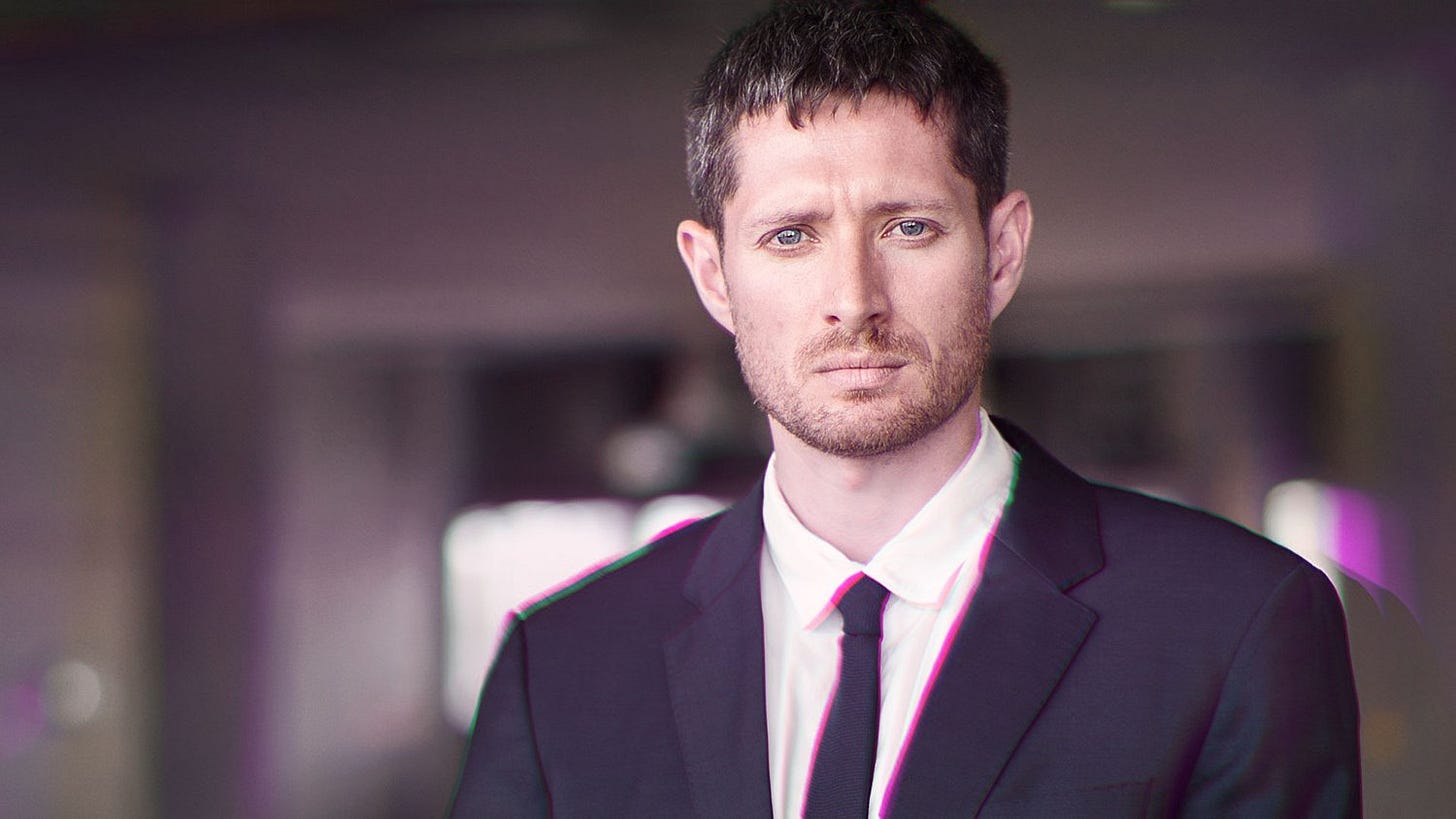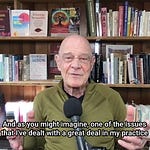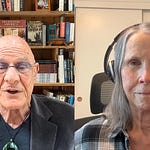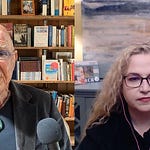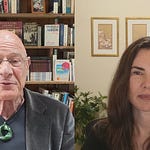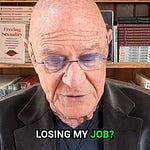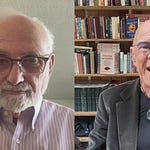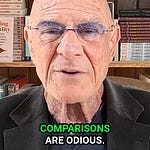Dear listener,
As a young psychologist in the 1950s, I saw the promising early research into psychedelic therapy. But a cultural backlash soon led to the criminalization of these substances. By the 1970s, the research had ground to a halt.
For decades, researchers had to lobby their own governments for permission to perform basic science. Beginning in the 2000s, however, a few pioneering researchers started to resume clinical trials against strong headwinds.
My first book, Psychedelic Medicine, documents those early studies, which paved the way for today’s renaissance, which is being led by a new generation of research talent. My guest this week, Dr. Robin Carhart-Harris, was born in 1980, meaning he was going through medical school just as the renaissance was beginning. He became a full professor at 40, and at 43, is already one of the most-cited researchers in the world.
Robin’s studies have shown remarkable improvements for conditions like depression and addiction using psychedelics – occasioning new insight, plasticity, and new neural connections. Brain imaging reveals psychedelics create more communication between disparate regions, with increased flexibility. However, while strong benefits exist, psychedelic experiences can be challenging without proper support and guidance. As Robin emphasizes, preparation, intention-setting, and integration are vital to ensure positive outcomes.
Because of the potential for adverse reactions in at-risk patients, Robin believes that these medicines should remain limited to regulated therapeutic contexts, and not legalized for personal consumption.
“Some might view my stance as trying to gatekeep this space,” he cautions, “but it’s important to prevent things from going awry, especially as we’re on the brink of a massive scale-up.”
Robin recounts a concerning case where a patient in one of his studies had a memory of a childhood trauma surface during a session. Neither the patient nor the researchers could tell if the memory was real, but the anxiety and turmoil the experience caused were undeniable.
Because of cases like this, Robin lead a study to look specifically at long-term negative reactions to psychedelics. It used online questionnaires and interviews to capture self-reported symptoms lasting over 72 hours. Participants had reactions like severe anxiety, panic attacks, temporary psychoses, and worsening of mental health conditions after chaotic or unsupported psychedelic experiences. Key findings included participant mental health history, set and setting risk factors, and complex causal mechanisms linking drug effects to contextual vulnerabilities. 37.5% of respondents received a new diagnosis post-experience. While limited in scope, the study aimed to balance the field’s positive bias by focusing exclusively on adverse reactions, advocating more research around safe use.
Here, I believe we can learn a great deal from the therapists working outside of research institutions – in both legal and underground clinics. Robin, too, is open to this kind of dialogue between academic researchers and physicians like himself and trained guides and psychologists.
“I want to learn from them, and I sense from trained therapists that they want to learn from me too. There’s a valuable reciprocity there.” Fostering understanding between science and traditional psychedelic healing enables responsible, ethical engagement with these powerful tools.
We stand on the cusp of a paradigm shift, with the psychedelic research renaissance now well underway. Robin aims to expand access to above-ground, regulated psychedelic therapy, recognizing this requires nuanced policies and integrative, humanistic treatment models focused on promoting wellness rather than just curing illness. At UCSF, Robin is now recruiting for a new study on psilocybin experiences in healthy adults to further knowledge in this burgeoning field. He has also created free online harm reduction education videos available on his website.
Let’s continue to push the frontier of knowledge with caution – unafraid of what we might uncover. Please join me in listening and sharing this important broadcast with your friends and family.
Golden Light,
Dr. Richard L. Miller
P.S. In the holiday spirit, I am discounting paid subscriptions by 20% until the end of the year. Subscribers get access to full transcripts. I am publishing this week’s transcript as a preview into the perks of being a member of our program. Please consider supporting us.
Mentioned in this Episode…
The Power Trip podcast series by Psymposia
Listen to learn…
What catalyzed the curent psychedelic science renaissance and what led Robin to move his work to the US?
What is the approval process like to conduct clinical trials with psychedelics?
What are the optimal psilocybin dosage ranges based on Robin's latest research findings?
What insights has Robin gained from studying complex therapy cases and adverse reactions to guide safe protocols?
Is there evidence showing psychedelics enhance creativity or shift political perspectives?
Do psychedelics make people more suggestible, and how does this inform psychedelic therapy?
How can we interpret brain imaging findings showing psychedelics' effects on neural connectivity?
What are Robin's perspectives from his research on microdosing and regular psychedelic use?
Why does Robin emphasize reciprocal learning between scientists and psychedelic guides?
Seeking Psychedelic Testimonials: The Good, the Bad, and the Ugly.
We are currently looking for first-hand accounts of adverse effects of psychedelics—from ‘bad trips,’ to unwanted physiological complications, to abusive practices by guides, therapists, and shamans.
The interviews from this series will go into a forthcoming book on the topic—perhaps the first book its kind.
Please contact me if you would like to be interviewed. You can also leave us a voice message to share your story. We will keep your information anonymous unless you tell us otherwise.
My Books
Freeing Sexuality: Psychologists, Consent Teachers, Polyamory Experts, and Sex Workers Speak Out
Psychedelic Wisdom: The Astonishing Rewards of Mind-Altering Substances
Psychedelic Medicine: The Healing Powers of LSD, MDMA, Psilocybin, and Ayahuasca
Integral Psychedelic Therapy (co-edited with Jason A. Butler & Genesee Herzberg)
NOTE: The podcast is always freely available thanks to our paid subscribers. Please share this post to show your support for transparency. The following transcript distills the key points from this show into a condensed form. It is meant as a reference - listen to the full episode for an accurate rendition of the conversation.
Transcript
Psychedelic science and its suppression.
Dr. Richard Miller:
Today on Mind, Body, Health, and Politics, we are privileged to have one of the world's foremost scientists with us, Dr. Robin Carhart-Harris. I've mentioned before that we've experienced a 50-year period of political repression and suppression of psychedelic science. We are now emerging from what felt like a 50-year wasteland. This period may not have been an absolute wasteland, but it certainly felt like one, especially since I lived through it. During this time, persistent scientists continually nudged the government for permission to conduct research. They asked for just a bit of leeway, a small opportunity to advance their work. These individuals were courageous, as there are fields in science that can be detrimental to one's career, such as psychedelic science, hypnosis, and human sexuality. However, Robin, along with a small group of scientists worldwide, persisted. The man we have with us today has conducted groundbreaking science and research. Welcome to Mind, Body, Health, and Politics, Robin.
Robin Carhart-Harris:
Thank you, Richard. It's a pleasure to be with you.
Psychedelic research transparency and safety.
Dr. Richard Miller:
Robin, what did it take to bring you to the United States after your remarkable career in England, where you were teaching at Imperial College and at the height of academia? Tell us a bit about the personal side. How did you make it across the pond?
Robin Carhart-Harris:
Well, I always felt welcome here. I met a lot of nice people who tempted me over, and a few key individuals helped make it a reality. People like Adam Gazzaley brought me into UCSF, and Michael Pollan, whom I got to know well around the time he was writing his book. I hinted to Michael that if anything popped up in his area, I'd be quite interested, and things started to develop from there. Of course, the allure of sunny California played a significant role as well.
Dr. Richard Miller:
It must have been a major logistical shift to set up a laboratory in the U.S. after establishing your systems in England, right?
Robin Carhart-Harris:
That's correct. It's taken time, but we're dosing now, which I'm pleased to report. It takes about two years, and I've heard from colleagues in the U.S. that it can take this long to set up clinical trials and studies with psychedelics. So, it's a long road to even get the approvals to do the work, but we're mostly through that now. We're currently dosing, and things are very good here. Things were good in London too, and I was fortunate to have a great team. We developed some momentum, and I could pass things on to my colleagues, who have kept things going. There are still trials that I helped set up that are running and will make an impact in the public domain probably next year, which feels good as well.
Psychedelic-assisted therapy for trauma recovery.
Dr. Richard Miller:
Robin, recent research in the field of psychedelic science, which you've been leading, raises some concerns. One is that, in our enthusiasm for this renaissance after half a century of suppressed science, it might catch on too quickly with the public, potentially leading to a situation reminiscent of the 1960s. This period became frightening, mostly due to media portrayal rather than actual events, but the end result was alarming for many. There's also concern about those treated by professionals. How transparent are we in the psychedelic science community going to be about what pharmaceutical companies term 'side effects', which I consider a sanitized way of referring to unwanted medicine complications or adverse effects? You've conducted research in this very area. Could you please discuss that research?
Robin Carhart-Harris: Sure. These interventions are potent. We began administering them to vulnerable populations around 2014-15, focusing on treatment-resistant depression. This was the first published trial in the modern era of psychedelic therapy for a population diagnosed with depression. There was also pioneering cancer work by individuals like Charlie Grob in end-of-life distress, but they didn't exclusively involve individuals with major depressive disorder, particularly not treatment-resistant depression. These patients had failed at least two medications and most had also undergone psychotherapy during their current depressive episode, making it a challenging group. We embarked on this with high ideals, as usual, and generally saw very good results. On average, we were successful in getting people into remission who hadn't responded to anything else.
However, to directly address your question, averaging results doesn't capture the complex cases. One particular individual comes to mind. After a relatively positive first session with 10 milligrams of psilocybin, he went into his second session a week later with 25 milligrams. During this session, he recalled what he believed was physical abuse from his father trying to smother him as a child. This recollection was confusing and destabilizing for him, as he had idolized his father and had a complex relationship with his mother, who was negative about his father following their divorce. This vision was very disturbing and inconsistent with his positive feelings towards his father. This example illustrates the complexity of the process. Instead of a positive, euphoric experience, he faced surprising and potentially repressed material. His depression score actually increased for a period after this session as he processed this difficult material.
This underscores the importance of providing thorough psychological support and advising against self-medicating with psychedelics. Even though such complex cases might be outliers, they are very real and significant for the individuals involved and can have serious repercussions. In this particular case, the individual, Andy, has spoken publicly about his experience.
Dr. Richard Miller:
Robin, couldn't it be said that the experience, while initially distressing, could have been extremely positive? If the therapist present during the uncovering of trauma was able to use the reliving of the emotional experience therapeutically, it might have helped release the individual from years of shame, guilt, and anxiety. This could relieve psychological pressure, as it's unlikely that we're completely unaware of repressed memories. Is that clear?
Robin Carhart-Harris:
Yes, that is the ideal scenario, where therapists, available before, during, and after the session, have undergone their own deep work and are experienced and trained to handle the recovery of repressed trauma. In Andy's case, it was not a memory of sexual abuse but rather serious physical abuse, assuming the memory was real. However, there's a delicate question, partly linked to the history of depth psychotherapy and psychoanalysis, about the authenticity of recovered memories and the possibility of them being false or imagined.
In our situation, we had mental health professionals, a clinical psychologist, and a psychiatrist as guides, but it wasn't clear to any of us whether the experience was real in a literal sense. Andy didn't relay his account in real time, but only after the event, making it a tricky case. We learned on the job, so to speak. Now, people might be wiser to these possibilities, and moving forward, we might improve training to better handle such cases.
Psychedelic therapy adverse effects and risk factors.
Dr. Richard Miller: You'll see where I'm coming from. As a clinician, I aim to help patients confront the most troubling aspects of their psyche, particularly the scariest parts, since these are often the root of most problems. Utilizing psychedelic medicines as a tool to access this material can be incredibly effective. However, it's crucial to ensure proper treatment. Without guidance, patients might be overwhelmed by these revelations, which would then constitute an adverse effect.
Robin Carhart-Harris: Indeed, I concur. This highlights the critical role of the therapist's skills and expertise, especially in complex cases. A flippant approach might suffice in simpler scenarios, but in complex ones, the therapist's skills, experience, and expertise become vital. Going forward, providing access to experienced mentors for guidance seems essential. Such support would enhance our ability to handle complex and challenging cases more effectively.
Dr. Richard Miller: It's also about leveraging your research, as it contributes to our understanding of specific cases. This could influence future medical guidelines, like those tiny printed instructions accompanying medications, identifying who should avoid certain drugs. Your work is adding to our body of knowledge, including insights about post-psychedelic experience anxiety.
Dr. Richard Miller: Could you tell us more about that, Robin?
Robin Carhart-Harris: Certainly. This stemmed from journalistic work on complex psychedelic therapy cases, both in ceremonial and trial settings. It led to a period of self-reflection and a decision to focus on negative responses for positive learning. We conducted a survey to collect cases, then selected the most complex for in-depth interviews. A key finding was that the predominant worsening mental health issue post-experience was anxiety, present in about 70-80% of cases. This was echoed in subsequent studies, reinforcing known risk factors like unsupervised sessions, 'bad trips', young age, unknown dosage or purity, and drug mixing. This work, although confirming suspected risks, was valuable in balancing the overly optimistic narrative around psychedelics, emphasizing the importance of proper understanding and caution in their therapeutic use.
Psilocybin research and administration practices.
Dr. Richard Miller: Robin, I interviewed a man the other day, named Justin Townsend, who has a center in Jamaica where he administers psilocybin, three different doses over a week-long period to people who come and spend the week. They do it in groups of 12. They start with three to five grams, and then the second time they take seven to nine, or even 10 grams. And then the third time, they may take as many as 15 grams of psilocybin. He's collecting some information. He says that the research that we scientists are doing around the world has a big question mark over it because it's being done in rooms in buildings. And the very setting, which the scientists are saying is so important, is a negative for all that research. Because he would never think of putting somebody in a room, laying them down on a bed, having two people sit there, and then give them a psychedelic medicine. Because it's an improper administration of the medicine. What do you think about that?
Robin Carhart-Harris: Well, I've got a few thoughts. So one is that in a treatment study, to give three doses within a week, would feel excessive, it would feel like too much drug within a short period of time, and perhaps too much emphasis on the drug and not enough on the supportive psychotherapy and processing, which sometimes they think for good reasons for safety and deep work, needs a bit of time, needs a little bit of lay off the dragon, do a bit more contemplation on working through. I suspect it's being done for financial and pragmatic reasons.
Dr. Richard Miller: They are doing therapy sessions in between the days that they're taking the psilocybin, and then they have some kind of group process that goes on afterward, on Zoom. But I think they also encourage people very strongly to get hooked up with a therapist to do the rest of the ongoing work. But the question I thought was a very interesting one. Was his questioning our administration process because of where it takes place?
Robin Carhart-Harris: Yeah, well, I guess I'm questioning his practice.
Dr. Richard Miller: They both may be questionable. We need something even better.
Robin Carhart-Harris: Well, to be fair, I think it's quite fair and reasonable to say, we know nothing of their results, as in we know nothing of their evidence, we know nothing of transparency in the process. So while we can speak to the science that's been published, we publish in quite a bit of detail, the procedure and protocol. We do publish all types of the responses in quite a lot of detail. So there's very good transparency and clarity there. And the important point is, the results are pretty impressive and have catalyzed all of the current interests, like Michael Pollan's book resting on the published science and so on. So it doesn't seem clear from the data from the evidence that the environments that we provide for people, which are very supportive, with music, listening through our mental health professionals, before, during, and after looking after people. We have very nice aesthetics in the low lighting and aspects of nature brought into the controlled environment. It's not clear from the actual evidence that it's a problem. So you know, I guess when you have a retreat with 13 or so people getting doses up to 15 grams, did I hear of...
Dr. Richard Miller: But I think I sent us on a red herring, talking about his program because I'm not meaning to or to test the efficacy. I'm more interested in that one particular point about the nature or of our setting for science because I can why I resonated to his comment, Robin, is because I've been self-experimenting with psychedelics for over 50 years, and I've experimented with just about every one imaginable. And I doubt very much if I would ever take a psychedelic in a room with a bed on it with just a room maybe with a window, and stay in the room the whole time. I mean, I might as an experiment, but in terms of the way I typically do it, I want a very pleasant atmosphere, I want to be able to look at nature, if I opened my eyes, I want to see the ocean, if I opened my eyes, I want to be able to feel expansive. And if I want to go into a room kind of situation, I close my eyes and put eye shades on and go deep inside. But I still prefer to do it in a quiet naturalistic setting than sort of what we call a room.
Robin Carhart-Harris: I think honestly, to be honest, Richard, I think there's too much projection on this room as something problematic. If it's quiet, the music's beautiful, played on a good sound system, and the lighting is low, and there is nature.
Dr. Richard Miller: You'd call it pleasant, is it a pleasant color?
Robin Carhart-Harris: I think it's more that the patients would call it pleasant. I mean, it's curated with a lot of good supportive intention.
Dr. Richard Miller: That's important information, because he may have a view based on what's been shown on television, which is a pretty sterile room in a building at Johns Hopkins. And it looks really sterile. And that's not a good image. You're painting more of a, you know, like the room you're in, or the room I'm in right now, what you might call cozier, more user-friendly.
Robin Carhart-Harris: I'm not sure what is a PC, but I've seen the Hopkins one, it's pretty nice. It's probably nicer still, when they dim the lights truly for a session, you know, sort of daytime lighting and so on. But they're a very experienced and professional team that republished great results. So again, I'm a scientist, and I'm giving it to you straight that, yeah, the evidence is pretty compelling for this for this room. I mean, in terms of adverse events, it is a question to ask, please, thank you. Are those more likely, when you're dosing very high, a larger number of people without the same ratio of professional psychological support to patient or participant or client again, sorry, but I have to say it, I wonder whether sometimes it's being done for economic reasons rather than quality care for an individual to be dosing 12-13 people with 15 grams of magic mushrooms, for example, these big doses done within a week period. Feels quite aggressive I think as a treatment model. It's not the way we've done it in our controlled trials.
Dr. Richard Miller: I love how you British are so diplomatically understated. Robin, I more years, I've been around these things. I've never heard of anybody doing 15 grams of mushrooms before. That's a dramatic number in my book, seven to eight is considered heroic by many people. Right. Heroic...
Robin Carhart-Harris: Heroic is putting a positive spin on it. Well said, heroic is another is reckless, perhaps. But yeah, that's very intensive, a very intensive treatment model.
Psychedelic dosage and creativity
Dr. Richard Miller: What was the range of doses you all used?
Robin Carhart-Harris: We've settled around 25 milligrams of psilocybin. The direct translation from a specific milligram of psilocybin to grams of mushrooms isn't well-established. It's often said that 25 milligrams of pure psilocybin is roughly equivalent to about three and a half grams of mushrooms.
Dr. Richard Miller: I think I've heard that from Nick Cozzi.
Robin Carhart-Harris: Yes, Nick Cozzi is a reliable source for that information. There's significant variability, though. Different mushroom strains and the varying concentrations of psilocybin and psilocin make it unreliable. This variability leads to a large margin of error when dosing with mushrooms. Considering the massive doses some are taking, I wonder about the strength of those mushrooms in terms of psilocybin content.
Dr. Richard Miller: Point well taken. So what would be considered a higher dose in milligrams of psilocybin?
Robin Carhart-Harris: We've found that doses start to plateau in effect around 30 milligrams. Beyond this point, there isn't much increase in the intensity of positive therapeutic aspects of the experience. We focus on emotional breakthroughs rather than mystical or spiritual experiences. Around 30 milligrams, you hit a plateau, and going higher may lead to confusion, disorganization in thought, and a decrease in the positive aspects of the experience, including insight. We think 25 to 30 milligrams is the sweet spot. Going above that risks negative effects without enhancing the positive ones.
Dr. Richard Miller: Would you hazard a guess on a dosage appropriate specifically for enhancing creativity?
Robin Carhart-Harris: That's tricky. The evidence for enhancements in creativity is mixed. We have many anecdotes, but it's hard to test in studies. So far, there's no clear response or evidence. The larger doses, like 25 to 30 milligrams, do promote psychological insight, but linking that directly to creativity is challenging. The evidence for psychedelics promoting creativity is more of an interesting hypothesis than a well-established fact. Creativity is difficult to pin down and study, which might explain the scarcity of clear evidence. However, there is compelling evidence that psychedelics promote psychological insight, fostering a deeper awareness of oneself and the causes of one's mental health challenges. This kind of self-awareness can be considered a form of creativity.
Dr. Richard Miller: So, it's a creative act, of course.
Robin Carhart-Harris: Yes, the hypothesis is interesting, but designing a good study to really demonstrate it is challenging. I'm aware of Jim Fadiman's work in the 60s around this hypothesis. However, if it were to be tested today, it would probably be conducted differently to better demonstrate the effect. More work needs to be done in this area.
Dr. Richard Miller: What research would you like to see done in psychedelic science? What's on our list?
Robin Carhart-Harris: One thing comes straight to mind. It's surprising that it hasn't been tested so far. We assume that psychedelic therapy is a combination treatment. It's implicit to those of us in the field, like myself, that psychological support is essential for the experience. It's not a drug-alone treatment. As we discussed earlier regarding the setting, and I got a bit defensive about our rooms, they are curated with supportive aesthetics in mind. We hold this belief strongly for both efficacy and safety, with a greater emphasis on safety. We think that if you're going to have these profound, often life-altering experiences, you need the right context and support. However, we haven't tested this assumption. It's explainable, as none of us want to jeopardize safety by reducing the quality of support. But this leaves us with an untested assumption. When you don't test such assumptions, which are universal across all modern trials with psychedelic therapy, people start to doubt them. Currently, there's a thought that perhaps the therapy aspect can be reduced, especially considering its cost. They want to reduce the expense, but this raises questions about the quality of treatment.
Psychedelic use and protection.
Dr. Richard Miller: I believe it can be seen as all of the above. I think the assumption that science is making is generally correct for the vast majority of people. However, the question being raised is more applicable to a smaller percentage of people, like myself. I have benefited both from taking psychedelics with a therapist and then having sessions afterwards, as well as from taking psychedelics alone. In both scenarios, I've learned things that have been dramatically helpful in my life. I wouldn't prioritize one over the other. But it's important to note that going into these sessions, I was a trained psychologist with a lot of experiences. I had undergone personal psychotherapy, practiced meditation, centering, and breathing, so I had many tools at my disposal. And I'm not the only one. There's a percentage of us that fall into this category. So, those questioning the scientific assumption are indeed raising a valid point regarding this particular group, though I can't specify how large it is. I know others exist in this group because I have friends who have had similar experiences and have benefited dramatically as well.
Robin Carhart-Harris: The reason I bring this up, and it connects to your introduction, is the concern that if the messaging suggests that the supportive context isn't very important, we might end up in a situation similar to the 1960s. The oversimplified message back then was just to take psychedelics, 'tune in, and drop out.'
Dr. Richard Miller: Yes, exactly. That's why I mentioned that the vast majority of people align with what science currently understands.
Robin Carhart-Harris: Right, and I think we're on the verge of significant societal shifts around psychedelics, especially with policy changes. This brings us to the crucial question: Should we legalize psychedelics? Should people be able to go to a place like Oakland, get a substantial dose of magic mushrooms with a small donation, and then consume them wherever they please, expecting positive psychological effects? This is a risky message and policy that could easily undermine the whole movement. Some might view my stance as trying to gatekeep this space, but it's important to prevent things from going awry, especially as we're on the brink of a massive scale-up. The use of psychedelics has already increased in the last decade.
Dr. Richard Miller: Indeed, I've seen statistics showing a doubling in the number of people using psilocybin in one year, from 3% to 6% of the American population. But what you're discussing, Robin, is about finding a balance between protection and paternalism. To what extent should we treat the public like children, and to what extent are we protecting them? I pose the question: to what extent does a person have a constitutional right to consume anything that grows in the ground or is made in a lab, as long as they don't harm another human being?
Robin Carhart-Harris: But you know, children are very vulnerable and require a certain degree of protection.
Dr. Richard Miller: I wasn't referring to children specifically.
Robin Carhart-Harris: Right, as an analogy. I understand what you mean. People under the influence of psychedelics are indeed very vulnerable. So, with that in mind, some degree of protection seems responsible, particularly when considering the transition from a complete ban on psychedelics to making them legally and freely available to everyone.
Psychedelics' effects on political views and suggestibility
Dr. Richard Miller: Robin, do you think that psychedelics have an effect on people's political positions? And I'm asking you this personally rather than just as a scientist.
Robin Carhart-Harris: Oh, gosh, you know, as a scientist, it's so easy to default to the scientific perspective. And I sort of feel obligated to do so because that's my area of expertise. We've always turned hunches into tests in science. So, we had this idea that psychedelics might make people more liberal, potentially moving them on the political spectrum away from conservatism towards liberalism. We tested this hypothesis. Generally, political perspectives are measured on an axis from conservatism on the right to liberalism on the left, and another axis from libertarianism to authoritarianism. What we found in two or three studies is a more reliable shift towards libertarianism and away from authoritarianism. It's less predictable whether people actually move towards liberalism. This was surprising to us. It seems more consistent that people shift towards libertarianism and anti-authoritarianism, which I find interesting. On a qualitative level, I do believe there is an intrinsic directionality here, where people gravitate towards being more free-thinking and less conformist after psychedelic experiences. This likely depends on context and social factors, but I think there's something to it.
Psychedelics and Suggestibility
Dr. Richard Miller: Let's talk about vulnerability and hyper-suggestibility. Has there been research indicating that people under the influence of psychedelics are more easily persuaded or suggestible? In other words, can they be more easily influenced if they were duped into taking these substances?
Robin Carhart-Harris: Yes, there is some evidence of this. Studies from the 60s inspired us to incorporate a suggestibility paradigm into an LSD study we conducted in London. We observed an enhancement in imaginative suggestibility. For instance, we suggested scenarios to participants, like imagining heavy dictionaries being placed on their hands, and observed their physical responses. This suggestibility was more pronounced under the influence of LSD compared to a placebo. Also, in our treatment trials, we found that those who are most suggestible typically have the best response to psychedelic therapy. This was demonstrated recently in psilocybin therapy for depression. Suggestibility, which is closely related to plasticity, the ability to be shaped or molded, seems to be enhanced by psychedelics. Those who are more plastic and suggestible at baseline also show the best response to psychedelic therapy.
Dr. Richard Miller: This speaks volumes about the use of psychedelics in groups, as group influence can significantly affect a suggestible person, which is quite different from taking them alone. Group therapy is being considered, mainly for financial reasons. And, by the way, your earlier point about the economic motivations behind some of these emerging centers is well taken. The prices can be exorbitant. Let's move on to harm reduction. Charlie wanted us to discuss this. Would you like to share your thoughts?
Robin Carhart-Harris: Yes, I'm happy to. Having played a role in the rise of psychedelic science and medicine, I've become more conscious of how I'd like things to progress and where I see vulnerabilities. The idea that people can easily access psychedelics and might not always be well-informed concerns me. About three years ago, I created a series of harm reduction videos. I looked into different distribution methods and eventually decided to make them freely available on my website, entirely open-source, with no paywall. I can't claim they're solidly evidence-based, as I haven't tested the material's impact on people. But based on my experience with various trials, working closely with mentors and therapists, and consulting experts like Bill Richards, I believe the material is well-informed. It's probably as good as anything available publicly. I made this decision because I worry about people's safety and believe it's essential for people to educate themselves on responsible psychedelic use to mitigate risks. The material includes general tips around psychedelics and incorporates elements of secular Buddhism, with quotes from Thich Nhat Hanh, Jack Kornfield, Stephen Batchelor, and others. These teachings offer wisdom rather than specific psychedelic guidance. I created this material with vulnerable individuals in mind, hoping it would be beneficial for those new to psychedelics.
Harm Reduction Series
Dr. Richard Miller: You mentioned that these harm reduction videos are on your website. Could you tell us a bit about your website? Then I have another question I want to ask.
Robin Carhart-Harris: Yes, I felt it was something I needed to do, so I created CarharttHarrisLab.com. I'm fortunate to have the freedom at UCSF to pursue projects like this. On my site, I've posted my papers, listed all my collaborators, provided some background, and uploaded all these open-source videos—there are about 25 of them. I've also archived interviews I've done. With your permission, Richard, I might put this interview up as well. The site serves as a hub for these materials, linking to content already in the public domain.
Dr. Richard Miller: I'd be honored if you put this interview on your website, and I will certainly put it on mine. Based on your research to date, what statements would you make to the psychedelic guides listening to this interview? What do you want to tell them?
Robin Carhart-Harris: Honestly, they could teach me a lot. I'm not a psychedelic guide; I'm a scientist. They're doing the heart work, and I'm more in the realm of head work. But I believe we can learn from each other. That would be my message. I want to learn from them, and I sense from trained therapists that they want to learn from me too. There's a valuable reciprocity there. For instance, I was fortunate to visit the Amazon and be the resident scientist in an authentic Shipibo-led ceremony. Despite the language barrier, there was a sweet mutual respect. I was deeply respectful of their methods and intrigued, and they were curious about my insights into the brain. I hope this kind of reciprocal learning and sharing continues. Sometimes scientists are seen as cold or unfeeling, and while we strive for objectivity, this doesn't mean hostility towards the therapeutic process. Trust and reciprocity require understanding each other's perspectives and approaches, so learning from each other is key.
Dr. Richard Miller: Thank you.
Psychedelics and Brain Imaging Studies
Dr. Richard Miller: Amanda Fielding is involved in digital imaging of the brain on LSD, which I'm sure you've seen, as we all have. From a scientific perspective, what are we to make of the difference between the brain on LSD and the brain not on LSD? Is it a dramatic representation? Then what do we do with it?
Robin Carhart-Harris: Well, we try to understand it, and I know that quite well.
Dr. Richard Miller: So help us understand it.
Robin Carhart-Harris: Sure. We conducted several brain imaging studies, and the one you're thinking of is probably the one using fMRI. Different modalities teach us different things. We used fMRI and EEG. The image that really resonated with people was the one with the two circles, showing communication between systems in the brain. This is a finding we've seen repeatedly, most recently with DMT, and now other teams are observing something similar. There's going to be a paper from a team in Maastricht about this. Essentially, there are two principles that could be combined into one. The first principle is the disintegration of networks or systems under the influence of the drug. We have several brain networks that perform different functions. For example, the visual system processes visual input, the motor system moves the body, and higher-level systems manage abstract cognition. Under the influence of drugs, these systems break down internally, with components becoming decoupled from each other. They also start to communicate more freely with other regions of the brain, including those belonging to systems they ordinarily don't interact with much. There's a shift away from the constraints of brain anatomy, where the functional connectivity and brain activity begin to diverge from their hard anatomical constraints. To put it more simply, the quality of communication in the brain becomes more global, varied, and I describe it as more entropic. This is formally true as well. It's harder to predict, richer, more complex, more open, and more flexible. These descriptors arise from the actual data and our functional understanding of the opening up of brain activity and communication.
Psychedelic therapy and microdosing. 1:08:28
Dr. Richard Miller: Are you getting that data from administrations of psilocybin, LSD, or something else?
Robin Carhart-Harris: The first was with psilocybin. Those two circles, which appeared in the centerfold of Michael Pollan's book, were under the effect of psilocybin, showing much more color across the brain. We also observed it with LSD and DMT. I'm not aware of anyone else looking at another psychedelic. Interestingly, we didn't see it under MDMA.
Dr. Richard Miller: You did not?
Robin Carhart-Harris: We did not, no. So, it could be a signature of the classic psychedelics.
Dr. Richard Miller: Yes, so given all those extremely positive consequences of taking these substances that you described, with the brain contacting more areas and moving around, wouldn't we want to take it regularly, not just for problems or pathology, but simply to gain those benefits?
Robin Carhart-Harris: They do sound positive. Flexible, open minds are desirable, but there's a caveat. Some data suggest that acute psychotic states may show similar qualities. An infant brain also shows this quality, which diminishes as we mature. Wordsworth spoke of the romance of the infant mind. But what would it mean to inhabit a permanently tripping mind and brain state? It may not be entirely positive.
Dr. Richard Miller: Amanda took 100 micrograms of LSD daily for 90 days in her youth and is still functioning well. Christian Rätsch took LSD on 93 occasions, each over 500 micrograms, and published his experiences. Amanda's experiment, especially, raises questions, as she did it daily without knowing the effects on serotonin and other neurotransmitters. It's interesting, considering how many people regularly take various medications. I once visited a hospital at 82, and the nurse was shocked I wasn't on any prescription medicines. She said she hadn't seen that in 35 years. It seems like we're discussing something risky, potentially seen as advocating for regular psychedelic use, similar to how pharmaceuticals operate.
Robin Carhart-Harris: Some of the benefits of psychedelic therapy could perhaps be achieved through spiritual practice. Respected figures like Ram Dass and Jack Kornfield turned more to spiritual practices rather than relying on psychedelics. They used their psychedelic experiences for insight and then developed it further with patient practice, rather than returning to the drugs. This isn't to rule out the drugs, but rather to emphasize the development of wisdom and self.
Dr. Richard Miller: And then there's the approach James Fadiman suggests, which is microdosing.
Robin Carhart-Harris: Microdosing is intriguing. The logic of slightly lubricating the mind is understandable.
Dr. Richard Miller: We're going to have research coming up on microdosing.
Robin Carhart-Harris: Yes, the jury's still out, but there are promising results suggesting the efficacy of microdosing. It's another approach, with a strong rationale. I believe microdosing works best when paired with psychological work. The microdoses may promote plasticity, which, combined with psychological training, could be very effective.
Discussion on Rupert Sheldrake's Theory of Morphic Resonance
Dr. Richard Miller: What do you think of Rupert's work on morphic resonance?
Robin Carhart-Harris: It's interesting. I don't understand it well enough and don't know the underlying mechanisms.
Dr. Richard Miller: I find it fascinating, though I'm not sure what to make of it. I interviewed him many years ago on "Mind Body Health and Politics". Since you're from England, that's why I mentioned it. But I do find it intriguing. Robin, it's been a distinct pleasure having you here today. Thank you for coming.
Robin Carhart-Harris: Thank you, Richard. I've enjoyed it very much.
Dr. Richard Miller: And thank you to all our listeners for joining us today on another episode of "Mind, Body Health and Politics". Remember, we air a new show every Tuesday at nine in the morning, and everything is archived at mindbodyhealthpolitics.org. Along with information on Robin Carhart-Harris's website, all our content is open source and free to access. Until next time, this is Dr. Richard Louis Miller reminding you that good health is worth fighting for and is essential for life, liberty, and the pursuit of happiness.

